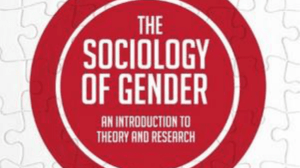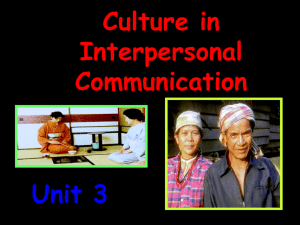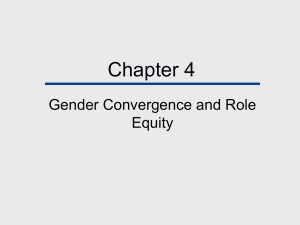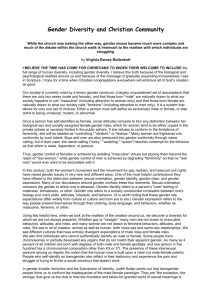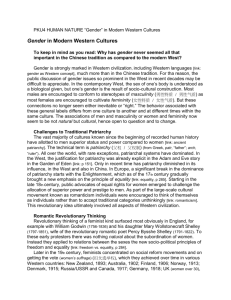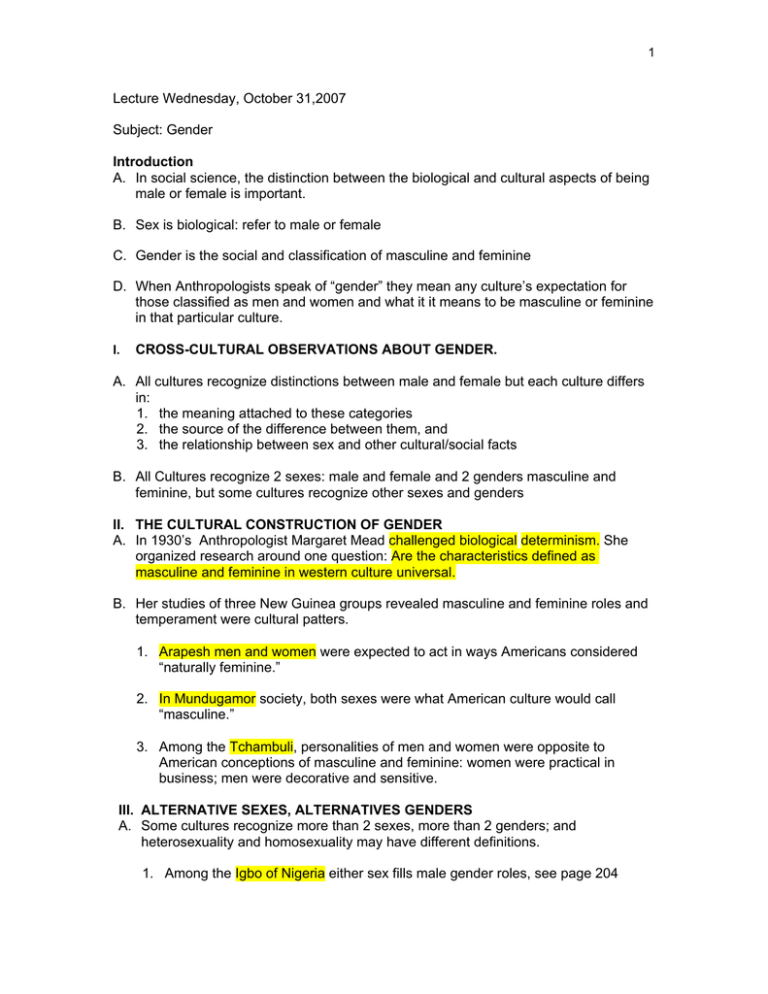
1
Lecture Wednesday, October 31,2007
Subject: Gender
Introduction
A. In social science, the distinction between the biological and cultural aspects of being
male or female is important.
B. Sex is biological: refer to male or female
C. Gender is the social and classification of masculine and feminine
D. When Anthropologists speak of “gender” they mean any culture’s expectation for
those classified as men and women and what it it means to be masculine or feminine
in that particular culture.
I.
CROSS-CULTURAL OBSERVATIONS ABOUT GENDER.
A. All cultures recognize distinctions between male and female but each culture differs
in:
1. the meaning attached to these categories
2. the source of the difference between them, and
3. the relationship between sex and other cultural/social facts
B. All Cultures recognize 2 sexes: male and female and 2 genders masculine and
feminine, but some cultures recognize other sexes and genders
II. THE CULTURAL CONSTRUCTION OF GENDER
A. In 1930’s Anthropologist Margaret Mead challenged biological determinism. She
organized research around one question: Are the characteristics defined as
masculine and feminine in western culture universal.
B. Her studies of three New Guinea groups revealed masculine and feminine roles and
temperament were cultural patters.
1. Arapesh men and women were expected to act in ways Americans considered
“naturally feminine.”
2. In Mundugamor society, both sexes were what American culture would call
“masculine.”
3. Among the Tchambuli, personalities of men and women were opposite to
American conceptions of masculine and feminine: women were practical in
business; men were decorative and sensitive.
III. ALTERNATIVE SEXES, ALTERNATIVES GENDERS
A. Some cultures recognize more than 2 sexes, more than 2 genders; and
heterosexuality and homosexuality may have different definitions.
1. Among the Igbo of Nigeria either sex fills male gender roles, see page 204
2
2. Women-woman marriage continues in more than 30 African groups despite
missionary disapproval; these relationships are not sexual.
a. in woman/woman marriages, the female husband takes on a variety of
economic and social gender roles depending on the culture
3. Alternate genders, i.e., neither man or woman) are the Xanith of Oman, the
Hijras, of India, and the Two-Spirit Role, in Native America. See page 204.
a. Hijras, see page 206, are emasculated through surgery; they adopt female
behavior and dress; their subculture is partly a religious cult and have a
place in Indian society as they perform at lifecycle ceremonies, i.e.,
marriages and births.
b. Two-Spirit role took different forms in different tribes and different value in
different tribes.
c. Two-Spirit role usually refers to a man who dressed as a woman, engaged
in man’s work and has supernatural powers.
d. The French term berache, used by European explorers and missionaries,
means male homosexual prostitute. However, the terms reflect European
rather than indigenous associations with crossing dressing and identifying
sexual object choice with gender identity.
IV. CULTURAL VARIATION IN SEXUAL BEHAVIOR
A. Cultures vary I their definition of appropriate sexual behavior.
1. Sexual activity is generally regarded as “doing what comes naturally,” yet every
aspect of sexual activity is patterned by culture and influenced by learning.
Cultural patterns include
a. how people treat different body parts.
b. what is considered erotic behavior and what is disgusting.
c. acts of foreplay
2. Appropriate sexual partners vary in different societies. Homosexuality may be
forbidden, approved, ignored or be obligatory, as it is among the Sambia of New
Guinea.
a. Among the Sambia, girls are viewed as “naturally” growing into woman, i.e.,
menstruation.
b. The Sambia believe that “women are born.”
c. The Sambia believes that the “menstrual blood” grows girls into women—
filling out their bodies and making them capable of pregnancy and childbirth.
3
d. Since men have no such “blood”, The Sambia believe that men must be
made. In other words, men are made not born. not born.
e. Masculinity is constructed in a ritual; this contrasts sharply with Western
notions that femininity and masculinity have strong biological components.
f.
The Sambia, like other New Guinea societies have a high degree of sex
segregation and hostility between the sexes enforces by powerful taboos.
g. Males and females live in separate houses. Between 7 and 10, young boys
are taken from their mothers and live with their fathers and other male kin.
h. Sambian males are “grown” in men through a series of male initiation rituals
beginning once they enter the male house.
i.
The ritual entails the obligatory homosexuality, i.e. the ingesting of semen,
which according to the Sambia, is necessary so that “maleness” grows.
V. SEXUAL BEHAVIOR AND IDEOLOGY: A CROSS CULTURAL COMPARISON.
A. The Irish of Inis Beag and the Polynesians of Mangaia clearly show the role of
culture in sexuality.
B. The sexually repressed Inis Beag regard all aspects of sex negatively.
C. Although in Mangaia, sexual intercourse is a major interest in life, it is unacceptable
conduct for boys and girls to be seen in public.
D. Values and physical responses of both peoples are learned as this section clearly
demonstrates.
VI. THE CONSTRUCTION OF MASCULINITY IN SPAIN
A. In the Andalusian region of Spain, control of female sexuality is central to the
construction of masculinity.
B. The view that women are lustful, seductresses and “whores” possessed of insatiable
sexual appetites is justified with reference to Christian scripture.
C. Medieval beliefs in women’s ability to overpower and weaken men through their
sexuality are given a contemporary twist by informants who claim women make
sexual demands that drive men to their premature death so they live off their
husbands’ entire social security benefits.
D. The cultural construction of manhood in San Blas (Southern Spain) opposes that of
women.
1. Space has gender: women belong to the home; men to the streets, bars and
public spaces
4
2. Men, fearful that their wives will be unfaithful and dishonor the family, adhere to
an image of manliness constituted by aggressive sexuality.



